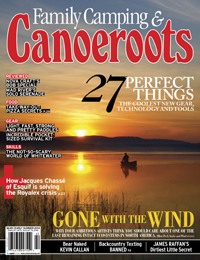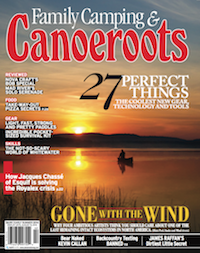If you’ve been living under a rock rather than scraping over them, you may not know that Royalex canoes are in short supply.
Manufacturer PolyOne announced last summer that it was calling it quits on the long-time favored hull material of whitewater and recreational canoes. Production of Royalex sheets ceased in March. The announcement sent the paddling community into a Royalex-boat-buying frenzy. Outfitters are bulking up their fleets while enthusiasts are buying backups of favorite models. Everyone is wondering about the future of the sport.
Jacques Chassé, owner of Esquif Canoes, thinks he has the magic bullet.
Beginning this fall, Esquif will begin replacing Royalex in its canoe line with a brand-new, in-house-made material they are calling T-Formex.
According to Chassé, paddlers can expect the same indestructability and performance of Royalex for approximately the same price. And he claims T-Formex will be 10 percent lighter and 20 times more abrasion resistant than Royalex.
“Seventy-five to 80 percent of our boats are now made from Royalex. We had no choice but to innovate,” says Chassé. “It’s not a secret I had been asking the manufacturer to improve their material but they weren’t interested. They’d been making Royalex for the last 35 years and there’s a lot of new plastic and new technology.”
Chassé is building a 6,000-square-foot T-Formex factory within Esquif’s existing 15,000-square-foot warehouse in southern Quebec.
“Because so many of our canoes were made from Royalex, we needed to find a material that could be used in the same molding stations in which the Royalex boats are shaped,” says Chassé. Switching to T-Formex will not require any re-tooling of this boat building operation. The same workshop will be able to produce the usual 20 to 25 canoes per day.
Like Royalex, T-Formex is manufactured into sheets using foam core, ABS plastic and another outer material Chassé won’t disclose. These are layered together to create a reinforced, multi-laminate sandwich that can withstand years of abuse.
At the time of publication, Chassé had just recently approached other canoe manufacturers. Before going public he wanted to let them know he had a new material coming and is hoping that T-Formex will replace Royalex in their canoe lines as well. No commitments had been made at the time of printing this issue of Canoeroots. In the meantime, Chassé is completing his factory-within-a-factory and setting up his operation to manufacture the T-Formex sheets needed to supply Esquif’s fleet.
“T-Formex is the only alternative to Royalex I know about,” says Chassé, adding that his first T-Formex prototype canoe hit the water mid-April. “I have very modest forecasts, but I’m pretty sure once the manufacturers and public see the properties of the material, everyone will step up and want to work with it. It’s the much improved material we’ve been waiting for.”
 This article first appeared in the Early Summer 2014 issue of Canoeroots Magazine.
This article first appeared in the Early Summer 2014 issue of Canoeroots Magazine.






 This article first appeared in the Early Summer 2014 issue of Canoeroots Magazine. For more great content, subscribe to Canoeroots’ print and digital editions
This article first appeared in the Early Summer 2014 issue of Canoeroots Magazine. For more great content, subscribe to Canoeroots’ print and digital editions 


 This article first appeared in the Early Summer 2014 issue of Canoeroots Magazine.
This article first appeared in the Early Summer 2014 issue of Canoeroots Magazine.

 Get the full article in the digital edition of Canoeroots Early Summer 2014.
Get the full article in the digital edition of Canoeroots Early Summer 2014. 